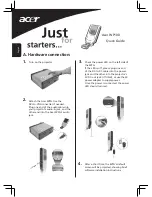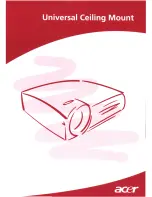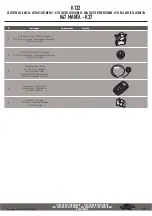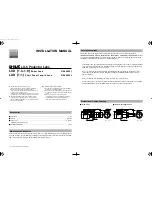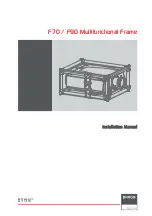
8
Introduction
A welding helmet is a type of headgear used when performing certain types of welding to
protect the eyes, face and neck from flash burn, ultraviolet light, sparks, infrared light, and
heat. The helmet consists of several parts (see spare parts list). An automatic welding filter
combines a passive UV and a passive IR filter with an active filter, the luminous transmittance
of which varies in the visible region of the spectrum, depending on the irradiance from the
welding arc. The luminous transmittance of the automatic welding filter has an initial high
value (light state). After the welding arc strikes and within a defined switching time, the
luminous transmittance of the filter changes to a low value (dark state). Depending on the
model, the helmet can be combined with a protective helmet and / or with a PAPR (Powered
Air Purifying Respirator) system.
Safety instructions
Please read the operating instructions before using the helmet. Check that the front cover
lens is fitted correctly. If it is not possible to eliminate errors, you must stop using the cartridge.
Precautions & protective restrictions / Risks
During the welding process, heat and radiation are released, which can cause damage to
the eyes and skin. This product offers protection for the eyes and face. When wearing the
helmet, your eyes are always protected against ultraviolet and infrared radiation, regardless
of the shade level. To protect the rest of your body, appropriate protective clothing must also
be worn. In some circumstances, particles and substances released by the welding process
can trigger allergic skin reactions in correspondingly predisposed persons. Materials that
come into contact with skin may cause allergic reactions to susceptible persons.
The protective welding helmet must only be used for welding and grinding and not for other
applications. The manufacturer assumes no liability when the welding helmet is used for
purposes other than intended or with disregard for the operating instructions. The helmet
is suitable for all established welding procedures, excluding gas and laser welding. Please
note the recommended protection level in accordance with EN169 on the cover. Scratched or
damaged lenses must be replaced. The helmet does not replace a safety helmet. Depending
on the model, the helmet can be combined with a protective helmet.
The helmet can affect the field of view due to constructive specifications (no view on the side
without turning the head) and may affect a color perception due to the light transmission
of the auto darkening filter. As a result, signal lights or warning indicators may not be seen.
Further there is an impact hazard due to a larger contour (head with helmet on). The helmet
also reduces the audio and heat perception.
Sleep mode
The cartridge has an automatic switch-off function, which increases the service life. If the
light falls on the catridge for a period of approx 10 minutes less than 1 Lux, it automatically
switches off. To reactivate the cartridge,it must be briefly exposed to daylight. If the shade
cartridge cannot be reactivated or does not darken when the welding arc is ignited, the
batteries must be replaced.
Warranty & liability
Please see the instructions of the national sales organisation of the manufacturer for warranty
provisions. For further information in this respect, please contact your official dealer. Warranty
is only granted for material and manufacturing defects. In the case of damage caused by
improper use, unauthorised intervention or through usage not intended by the manufacturer,
the warranty or liability are no longer valid. Likewise, liability and the warranty are no longer
valid if spare parts other than those sold by the manufacturer are used.
Expected Lifetime
The welding helmet has no expiration date. The product can be used as long as no visible
or invisible damage or functional problems occur.
How to use (Quick Start Guide)
1. Head band (p. 2-3) Adjust the upper adjusting band to the size of your head. Push in the
ratchet knob (p. 2) and turn until the head band fits securely but without pressure.
2. Distance from eyes and helmet angle (p. 2-3) By releasing the locking knobs, the distance
between the cartridge and the eyes can be adjusted. Adjust both sides equally and do
not tilt. Then tighten the locking knobs again. The helmet angle can be adjusted using
the rotary knob.
3. Autopilot/ Shade Level (p. 6) This welding helmet has an automatic shade level setting
"Autopilot" adjusted to the intensity of the light arc via sensors. This welding helmet
covers all shade levels between 5 and 14 (according to EN 379) in the active state. The
ADF should be used at the start in the neutral position "N" and corrected via rotary knob
according to personal preference by up to two shade levels up or down.
4. Grinding / visual inspection (p. 2-3) By folding the ADF up, the welding helmet can be
used for grinding or visual inspections without compromising on safety. Never grind
without the safety lens.
5. Sensitivity (p.6) With the sensitivity button the light sensitivity is adjusted according to
the welding arc and the ambient light. By turning the knob, these can be customized
adapted to the application, the environment and the welding process. In the "Super High"
range the maximum light sensitivity can be achieved.
6. Delay switch (p. 6) The opening delay switch (Delay) allows to select an opening delay
from dark to light. The switch is located under the battery cover and allows a choice of
0.3s "Fast" or 1.5 "Twilight" (with fading effect). The Twilight setting is not suitable for
high frequent tack welding applications
For tack welding the "Fast" setting is recommended.
Cleaning and disinfection
The shade cartridge and the front cover lens must be cleaned with a soft cloth at regular
intervals. No strong cleaning agents, solvents, alcohol or cleaning agents containing scouring
agent must be used. Scratched or damaged lenses must be replaced.
Storage
The welding helmet must be stored at room temperature and with low air humidity. Storing
the helmet in the original packaging or in the included storage bag will increase the service
life of the batteries.
Removing / installing the ADF (p. 4-5)
1. Fold the flip adapter up
2. Press the latch by pressing down slightliy the opening sash (on right side)
3. Slide the ADF simultaneously with the other hand out of the adapter to the right until the
ADF is removed completely.
The shade cartridge is installed in the reverse order.
Replacing the front cover lens (p. 4-5)
Before changing the front cover lens, the ADF must be removed. See the previous section
"Removing / installing the ADF". After removing the ADF the front cover lens can be pulled out
easily from the flip adapter. The front cover lens is installed in the reverse order.
Replacing the inside cover lens. (p. 4-5)
Before changing the inside cover lens, the ADF must be removed. See the previous section
"Removing / installing the ADF". Lift the inside cover lens slightly in the middle and pulling it
downward. The inside cover lens is installed in the reverse order.
Replacing the safety lens / grinding lens (p. 4-5)
1. Fold up the flip adapter. Press the safety lens strongly in the middle to the outside.
2. Slip the new safety lens to the left or right between the lower frame and the holder.
3. Press it with the lower hand, centrally upwards. At the same time you have to press the
unfixed edge with the upper hand downwards until the lens can be fixed on the other side
between the frame and the holder (for this step the safety lens must be buckled shortly to be
able to place it properly).
Replacing the batteries (p. 2-3)
The shade cartridge has replaceable lithium button cell batteries, type CR2032. The batteries
must be replaced when the LED on the cartridge flashes in red.
1. Carefully remove battery cover
2. Remove batteries and dispose of in accordance with the national regulations for special
waste
3. Use type CR2032 batteries as depicted
4. Carefully remount battery cover
If the shade cartridge does not darken when the welding arc is ignited, please check battery
polarity. To check whether the batteries still have sufficient power, hold the shade cartridge
against a bright lamp. If the red LED flashes, the batteries are empty and must be replaced
immediately. If the shade cartridge does not operate correctly in spite of correct battery
replacement, it must be declared unusable and must be replaced.
Troubleshooting
Cartridge does not darken
→ Adjust sensitivity
→ Replace the batteries (p. 2-3)
→ Clean sensors or front cover lens
→ Check the light flow to the sensor (do not cover the sensors)
Protection level too light
→ adjust shade level correction according individual preference up to 2 additional shade levels
→ Replace front cover lens (dirty cover lenses can interfere with sensors)
Protection level too dark
→ adjust shade level correction according individual preference up to minus 2 additional
shade levels
Cartridge flickers
→ Adjust position of the delay switch to "Fast" → Replace the batteries (p. 2-3)
Poor vision
→ Clean the front cover lens, inside cover lens, grinding lens or ADF
→ Adjust the shade level correction to the welding procedure → Increase the ambient light
Welding helmet slips
→ Adjust/tighten the head band (p. 2-3)
Specifications
(Right reserved to make technical changes)
Shade level
shade level 1 (open flip adapter)
shade level 4 (bright mode, folded flip adapter)
shade level 5<14 (dark mode, folded flip adapater)
UV/IR protection
Maximum protection in light and dark modes (folded
flip adapter)
Switching time from light to dark
0.1 ms (23°C / 73°F) 0.1 ms (55°C / 131°F)
Switching time from dark to light
"Fast" = 0.3 s
"Twilight" = 1.5 s with fading effect
Shade cartridge dimensions
90 x 110 x 9.5mm / 3.54 x 4.33 x 0.37"
Field of view dimensions
50 x 100mm / 1.97 x 3.94"
Power supply
Solar cells, 2 pcs. replaceable 3V LI-batteries (CR2032)
weight standard welding helmet (incl. ADF)
weight PAPR welding helmet (incl. ADF)
weight ADF
530 g / 18.7 oz
730 g / 25.8 oz
100 g / 3.5 oz
Operating temperature
-10 °C – 70 °C / 14 °F – 157 °F
Storage temperature
-20°C – 70°C / -4°F – 157°F
Classification in accordance with EN379
Optical class = 1 Homogeneity = 1
Scattered light = 1 Viewing angle dependence = 2
Certifications
CE, ANSI, EAC, complies with CSA
Additional markings for PAPR version
(notified body CE1024)
EN12491 (TH3 in combination with e3000, TH2 for
versions with hardhat and e3000)
Spare parts (p. 5-6)
-helmet shell without ADF (5001.916)
-complete headband (5003.250)
-PAPR helmet shell without ADF (4290.000) -sweatband/ comfortband (5004.073 / 5004.020)
-Auto Darkening Filter (5012.490)
-front cover lens (5000.391)
-inside cover lens (5000.001)
-safety lens (5000.390)
Declaration of conformity
See internet link adress at last page.
Legal information
This document complies with the requirements of EU regulation 2016/425 point 1.4 of
Annex II.
Notified body
See last page for detailed information.
English
Summary of Contents for LiteFlip Autopilot
Page 2: ......
Page 3: ......
Page 4: ......
Page 5: ......
Page 6: ......
Page 34: ...Notes...
Page 35: ...Notes...
























